Hi Readers!
Welcome back to another blog of mine! I know it’s been a while since the last post. As all of you should have guessed by the title, today’s post is on the “Singaporean Food and Food Culture”.
So when you hear Singaporean Cuisine, what thought comes to your mind at instant? Don’t feel shy, let me know by commenting in the comment section below!

I’ve been back from my trip to Singapore for about a couple of months now and I feel like I’ve only begun to wrap my head around the depth and diversity of the food scene there. Singapore is a tiny country with a voracious appetite: “we’ll eat five or six meals a day,” one local told me. “I’m not saying that to impress you—we really do.”
Singapore is a nation full of contradictions: a fervent post-colonial drive to be Western in all things against a patchwork of immigrant cultural traditions that refuse to be ignored. Food from Singapore hails from everywhere, but also, in a sense, from nowhere: the local cuisine is defined by what it’s borrowed, and how those puzzle pieces are assembled into something totally unique.
What is Singaporean cuisine? It’s food you eat in Singapore. Bak kut teh may have come from Southern China, and fish head curry from Southern India, but today they’re just Singaporean.
It’s a crazy country that can set your head spinning, but food, of all things, will keep you grounded. You’ll find fragrant coconut jam on toast in the shadow of skyscrapers, and hear the crack of crab shells in the alleys of red light districts. Wherever I was, and whatever I was doing, I always had the sense that I was in the company of people who cared deeply about what they ate. I could spend the rest of my life eating in hawker centers.

If I had to briefly answer what I learned from my trip, it’s this: my cheapest meals were some of my best, I could spend the rest of my life eating in hawker centers, and these people know how to make noodles. You could spend a trip—or an expat’s lifetime (not that I’ve thought about it or anything)—eating nothing but noodles for less than $5, and feel like you’re on top of the world.
If there’s anything that ties the endless array of Singaporean food together, it’s how good they make humble ingredients taste. A plate of rice and egg noodles stir-fried with shrimp stock and lard tastes way more vibrant and interesting than you’d think it has any right to. A spoonful of quivering tofu from a plastic carton will change your relationship with bean curd.
This kind of perfection in simplicity can only come from a place where eating is a way of life unto itself. And where a meal is judged solely by what comes on the plate—fancy restaurants and big name chefs not necessary.

Singapore is seated at the cultural crossroads of an entire food-crazy continent. By the numbers, it’s roughly 74% Chinese, 13% ethnic Malay, 9% Indian, and 3% Eurasian. As one of the wealthiest countries in Asia, it’s drawn workers in from everywhere, and where large populations of immigrant workers go, good food is sure to follow. Singapore feels similar to New York in this way: not only is it a glass-towered metropolis of wealth; it’s also a hotbed for a half dozen or so different ethnic groups making—and cooking—their way through the world.
Some fascinating cultural fusion has emerged as a result. The Peranakan/Nyonya population is the product of marriage between Chinese immigrants and Malaysian natives, which has created a food culture all its own. The Indian food satisfies Asian tastes as much as anything else; some of the dishes bear only a passing resemblance to their Indian subcontinent counterparts. And ingredients from everywhere figure into the local cuisine; I mean centuries-old cultural borrowings and brand-new imports that arrive every day.
There are plenty of distinct dishes, though. Many of the Chinese recipes are straight imports from their Hokkien and Teocheow homes, even if they’ve underwent local modification over the decades. Still, I get the sense that Singaporeans are less likely to go out for Chinese or Indian than they are to just go out and eat everything in sight. When your whole country is an ethnic maelstrom of people from all over, quibbles over exacting cultural boundaries or notions of authenticity feel quaint.
Most Asian cultures are rice- or noodle-focused, but in Singapore they’re both. Noodles are typically served stir fried or in soup. The Malay dishes (such as these) are usually based on a foundation of spicy, fishy sambal, sour herbs, and/or complex citrus. Their heat typically comes from a wallop of chili paste stirred into broth, or a small dish of even hotter sauce on the side.
Chinese-inspired noodles, which were the bulk I came across, are a little less complex but no less fantastic. The smoky kiss of the wok really shines in stir-fried hokkien mee; a superb dish of wonton mee was all about the hoisin-sweet and pickle-sour sauce touched up with just a dab of chile paste and some ridiculous roast pork. Noodle broths are typically pork-, chicken- or shrimp-based.
Coconutty laksa and mucilaginous lor mee excepted, they tend towards the thin side, but they deliver powerful flavors. The soups that accompanied my noodles never tasted random or incidental; cooks intelligently combine them with specific noodles, proteins, and vegetables to make a complete dish.

Most rice dishes, be they Chinese, Indian, or otherwise, tend to be of the “over rice” variety. Think a subtly spiced biryani topped with a rich chicken curry gravy, or gingery poached chicken heaped rice cooked in the chicken’s broth. Rice can of course accompany anything, but if you’re eating at a Hawker Center, you won’t have a waiter bringing you rice to sop up your stir fry sauces. Rice dishes in Singapore tend to be just that: dishes, not accompaniments.
You’ll hear that crab is the national dish, and that’s true depending on who you talk to, but shrimp—always called prawns—are the every day seafood. Singapore has virtually no domestic agriculture, fish, or meat industry, so most ingredients, seafood included, have to be imported. But that means majestic platters of chili crab, shrimp in every conceivable style, and bubbling cauldrons of fish head hurry are never in short supply. In the West, fish tends to be seen the demure alternative to meat. And if not an alternative, at least a more subtle, clean protein paired with quieter flavors. That is not, in my experience, how they do fish in Singapore.
Whether eaten straight, blended into juice, or used as a topping in a shaved ice dessert, a wealth of tropical fruit is an important part of the Singaporean diet. There is, of course, the famously stinky durian, which Singaporeans can’t get enough of. The durian I’ve had in the U.S. has always had a rotting flesh flavor with hints of almond and overripe apricot; in Singapore it’s even more intimidating. The custardy fruit boasts a hot, brash kiss of garlic breath that more than once stopped me in my tracks.
Another essential: calamansi lime, which makes its way into so many dishes it could be a food group. Carey perfectly described it as having “a complicated, compelling flavor that’s simultaneously sweet and acidic and refreshingly bright—lime meets kumquat meets tangerine, say.” The broths, chili pastes, and drinks of the country just wouldn’t be the same without its cool, slightly herbal citrus vibe.
Other popular fruits include mangosteen, lychee, spiky rambutan, and deliriously sweet longan and sugar cane (durian and calamansi excepted, Singaporeans seem to like their fruit on the sweet side). Coconut, when not used for creaminess in a bowl of laksa or cendol, is bought for its water, drunk straight. Water from small Thai coconuts is on the sweeter side, but the larger, more common green-skinned coconuts have a more nutty, sour flavor.
You can’t talk about Southeast Asia without talking about the spice trade. As an island off Malaysia, Singapore has been exposed to every spice, cuisine, and crook from the old spice routes. But since Singapore is mostly Chinese, spices figure less heavily into the cuisine than in Malaysia.
That said, virtually any spice that grows in India can be found here, and the Indian curries, which are thinner and much more intense than Westerners may be used to, aren’t afraid to use them all. Malay dishes employ a range of exotic fruits and herbs with Indian and Thai spices; Indonesian ones like satay with spicy-sweet peanut sauce also aren’t afraid to give South Asian spices the Southeast Asian treatment. Ginger, black and white peppers, and chilies figure heavily into some of the country’s most iconic dishes: chili and pepper crabs and Hainan chicken rice.
That said, if you’re wary of too much heat, take comfort in knowing that you can navigate Singapore’s culinary landscape quite easily without touching spicy food. Most of my favorite dishes—to my great surprise—had no heat at all.
Of course this barely touches on all the incredible variety of Singaporean cuisine: crisp-chewy roti prata, dreamlike rice porridge, garlicky pork rib soup, briny fried oyster omelets, savory fish paste grilled in banana leaves, tender daikon radish cake with eggs and molasses-ey soy sauce…you get the idea. Plus I’ve barely touched on breakfast, sweets, and the country’s national specialties. As I file more stories on Singapore over the next few weeks, we’ll keep this post updated as an index of everything Singapore culinary.
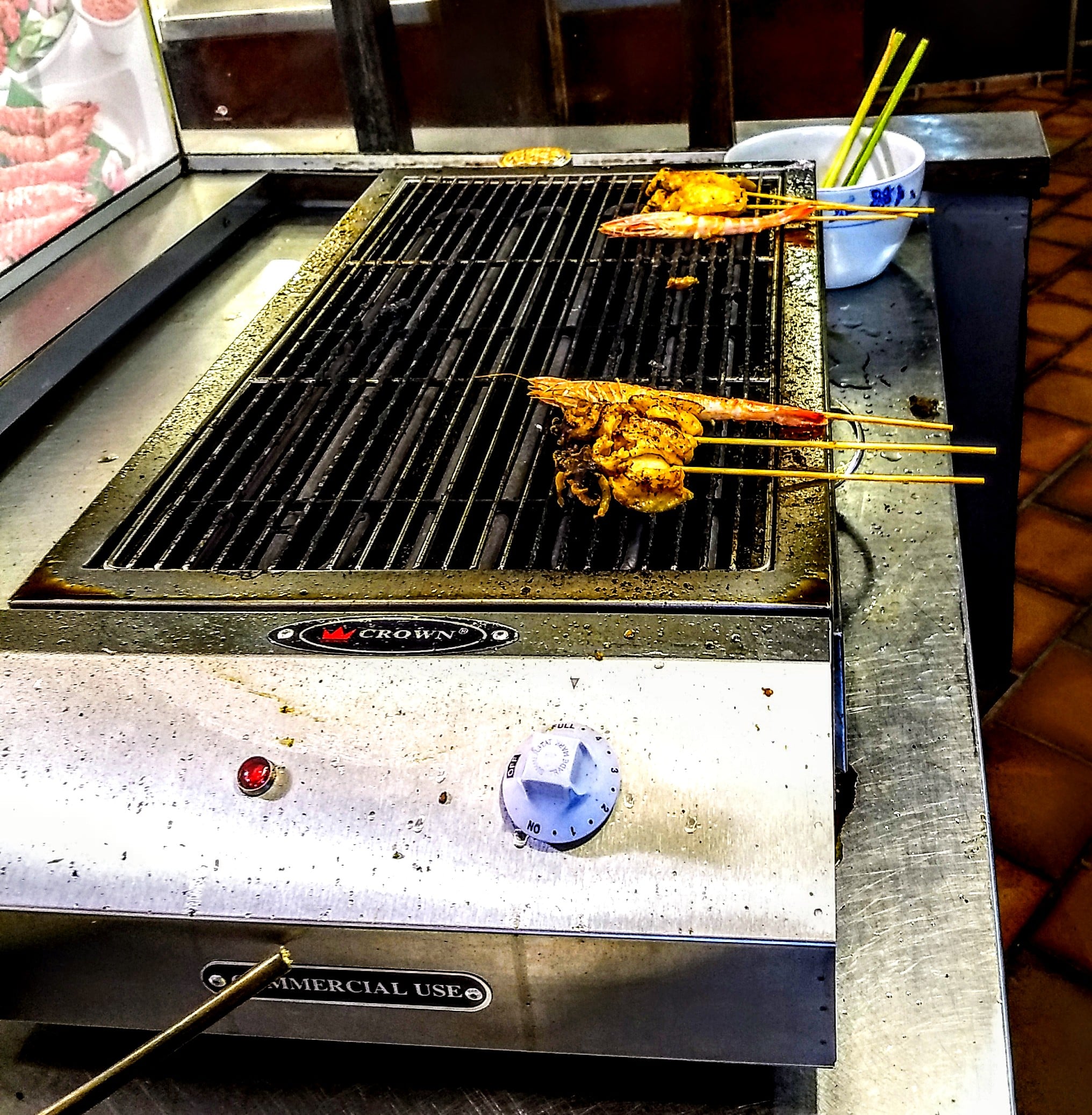
You may have heard people call Singapore a street food mecca, and that’s true, but not in the sense you may be used to. The government banned hawking in the street decades ago; hawkers are now housed in open air (but enclosed) Hawker Centers, which are something like food courts, but an institution all their own.
Hawker Centers are the hot, humid, frenetic lifeblood of Singaporean food culture. They’re owned by the government and house scores (and sometimes hundreds) of individual hawkers that usually specialize in a couple of dishes, if that many. You’ll have your chicken rice guy, your fritter lady, and your char kueh teow wokstar—and everyone has their wokstar. Singaporeans will queue up for half an hour just to get their perfect plate of noodles or bowl of soup.
You’ll find hawker centers near public housing buildings (which accommodate 85% of the country’s population) and in larger markets. As far as street food goes, they’re pretty clean and well-managed, the kind of place where tables are wiped down frequently by staff and a pack of tissues or an unattended backpack is an accepted and perfectly safe way to save your seat.
Cze Chas are open-air restaurants (though many that take the name are also enclosed) with much lengthier menus than you’ll find at Hawker stalls. There’s table service here, and you’ll be dining in the company of a couple dozen people, not hundreds like at a Hawker Center. Cze Chas may specialize in a single dish or a few dozen; the quality of the food, and the opportunity for people watching, can be just as top-notch as at a Hawker Center.

You’ll see other small lots with a few devoted tables out front for cooks who specialize in a couple foods but want a space larger than what a Hawker Center affords. I saw a number of fresh bean curd spots on my trip, but also one devoted to “Pig Organ Soup.” As these single-serving places are often close by to others, they form a sort of Ur-Hawker Center on the street.
There are, of course, full-fledged indoor (air conditioned!) restaurants in Singapore, which tend to specialize in a specific cuisine. They’re typically classier operations: the dishware is made of ceramic, not plastic; you’re not hit with the smell of a dozen different woks going at it; and you’ll have a server paid to be nice to you.
There are also food courts, which are are indoors, often in malls. Avoid them; they focus on comfort and packaging, and are usually run by corporations whose first priority definitely isn’t good food.
I’d be remiss to not mention that there’s an ever growing fine dining scene in the country, one of the many outlets for a Western-aspirational (and wealthy) sector of the public. The good ones, like Tung Lok Seafood or the newly opened Pollen in the brand-new Gardens by the Bay project, are very good. But beware that many fine dining restaurants cater to the tourist and Western expat market, and may not be as tied to the unforgiving Singaporean criterion for good food regardless of setting and after you receive your third or so plate from a smiling hawker who’s spent his or her life perfecting one or two dishes, something clicks. You realize this food isn’t just about food, or even about the culinary magic of teasing big flavors from humble ingredients. The earth spins fast in Singapore; tradition has to fight to keep up. In this country of immigrants, “where you’re from” and “where you’re going” become relative questions. Food points the way.
iEat-iShoot-iPost is the most popular food blog in Singapore, with incredible coverage of the hawker scene that includes accurate locations and hours of operation. The author, Dr. Leslie Tay, has also published a book and iPhone app that are well worth buying.
Not a Tourist is a blog that encourages expats the discover the local culture. It covers more than just food, and is a great insider’s guide.
Makansutra is K. F. Seetoh’s annually published guide book and website all about celebrating local food.
While I was in Singapore, I had a lot of fun with food. Starting from Indian cuisine to hardcore Singaporean cuisine, I tasted everything. Singaporean knows their spices well and from light food to spicy food, they can embrace it all. Beings an island country, the staple food of Singapore is fried chicken with rice with lots of seafood available from squids, octopus, mackerel, salmon, prawns, crabs, etc to chicken, pork, beef, lamb, etc. everything is found at Singapore.
The traditional Singaporean food which I tasted were:
Hainanese Chicken Rice: Hainanese chicken rice is a dish of poached chicken and seasoned rice, served with chilli sauce and usually comes with cucumber garnishes. It was created by immigrants from Hainan province in southern China and adapted from the Hainanese dish Wenchang chicken. It is considered one of the national dishes of Singapore and is most commonly associated with Singaporean cuisine. The chicken is prepared in accordance with traditional Hainanese methods, which involve poaching the entire chicken at sub-boiling temperatures to both cook the bird and produce the stock. The bird is dipped in ice after cooking to produce a jelly-like skin finishing and hung to dry. The stock is skimmed of fat and some of the fat and liquid, along with ginger, garlic, and pandan leaves, are used in the cooking of the rice, producing a bowl of oily, flavourful rice sometimes known as “oily rice”. In Singapore “the most important part of chicken rice is not the chicken, but the rice.” The dish is served with a dipping sauce of freshly minced red chilli and garlic, usually accompanied with dark soy sauce and freshly ground ginger. Fresh cucumber boiled in the chicken broth and light soy sauce with a dash of sesame oil is served with the chicken, which is usually served at room temperature.

Siamese Noodles: It is a dish of thin rice vermicelli, originating from Maritime Southeast Asia, popular in Singapore and Malaysia. It is said to have originated either from the Malay or Peranakan community. As the name suggests, it is inspired or adapted from Thai flavours. In Singapore, it is served with spicy, sweet and sour light gravy. The gravy is made from a rempah spice paste, tamarind and taucheo (salted soy bean). Mee Siam is typically garnished with the shredded omelette, scallions, bean sprouts, garlic chives, and lime wedges. In Malaysia, a “dry” version is more commonly found, which is essentially stir-frying the rice noodles with the same ingredients used in the Singaporean version. The sauce is made from coconut milk mixed with minced pork, prawns, firm bean curd, salted soybean, bean sprouts, garlic chives, and tamarind. It is served with thinly sliced egg omelette, fresh bean sprouts, fresh garlic and banana blossom.

Steak: a chunk of meat drizzled with the fat cut from the breast part of the goat, tossed in garlic butter gravy with chillies, topped with french fries and garnished with a pinch of coriander leaves and baby tomatoes. A blend of Europe with Singaporean touch is heavenly and worthy of every Singaporean Dollar. It’s absolutely majestic in flavour to texture and the way it melts in the mouth. Bliss!

Rong Hua: Delicious chunk of lamb meat from the rear leg is boiled and the stock is prepared into a stew by boiling on low flame with chunks of ginger, pepper and potatoes. The food is non-spicy but does tingle the taste buds. Preferred to have with a loaf of bread.

Carousel: It is a combination dish of steamed rice with dried fish topped with a tangy spicy red sauce. The flavour of smoky dried fish with the sauce when entangles the rice, it creates a very unique flavour which will make your mouth water.

Chilli Crab: Chilli crab is a Singaporean seafood dish. Mud crabs are commonly used and are stir-fried in a semi-thick, sweet and savoury tomato and chilli based sauce. Despite its name, chilli crab is not a very spicy dish. It is listed at number 35 on the World’s 50 most delicious foods compiled by CNN Go in 2011. Chilli crab has been promoted by The Singapore Tourism Board as one of Singapore’s National Dishes and can be found in seafood restaurants all over the island. It is traditionally eaten with bare hands as a means to savour the juicy crab meat with its sweet and spicy chilli sauce. Restaurants often provide wet towels or a washing bowl with lime in order to cleanse your hands after the meal. Chilli crab sauce is described as “sensuous” and “sweet, yet savoury”, with a “fluffy texture”. Mud crabs ( Scylla serrata ) are the most common type of crabs used for the dish, although other species of crab can be used too.

The coffees in Singapore were mainly of Pokka Coffee (canned). There are outlets of Starbucks even at Changi Airport and I also loved the rich Arabica Coffee from Tangerine.
Singaporean are found of juices and there are juice machines throughout the city, being the orange lover I didn’t miss the opportunity to taste the refreshing orange juices from Orange and Super Dream and lime juice from Bugis Street.
Coca Cola is also largely available in Singapore.

Singapore has a variety of dishes for the sweet lovers – They have Tea Chocolates, Burger Biscuits by TWG at Mariana Bay. Yummy marshmallow cookie cream ice-cream from Haagen-Dazs and amazing chocolate doughnuts from Krispy Kreme again located at Changi Airport. They also have mouth melting Tiramisu Creamcake at the canteen of the National University of Singapore.
There is a place in Singapore called Little India. The place is famous for Indian cuisine available there. So we went to the restaurant called Delhi 6 which is owned and run by Bangladeshi chef Aftab and his family. The team were very friendly, warm and welcoming.
I had:
Buttermilk/Lassi: Who doesn’t love this hearty Punjabi summer cooler? Often touted as the oldest smoothie in the world, a sip of luscious lassi often served with a dollop of decadent malai cascading down your parched throat can instantly lift your mood and provide relief from the sultry heat. It is prepared by blending yoghurt with water with added salt.
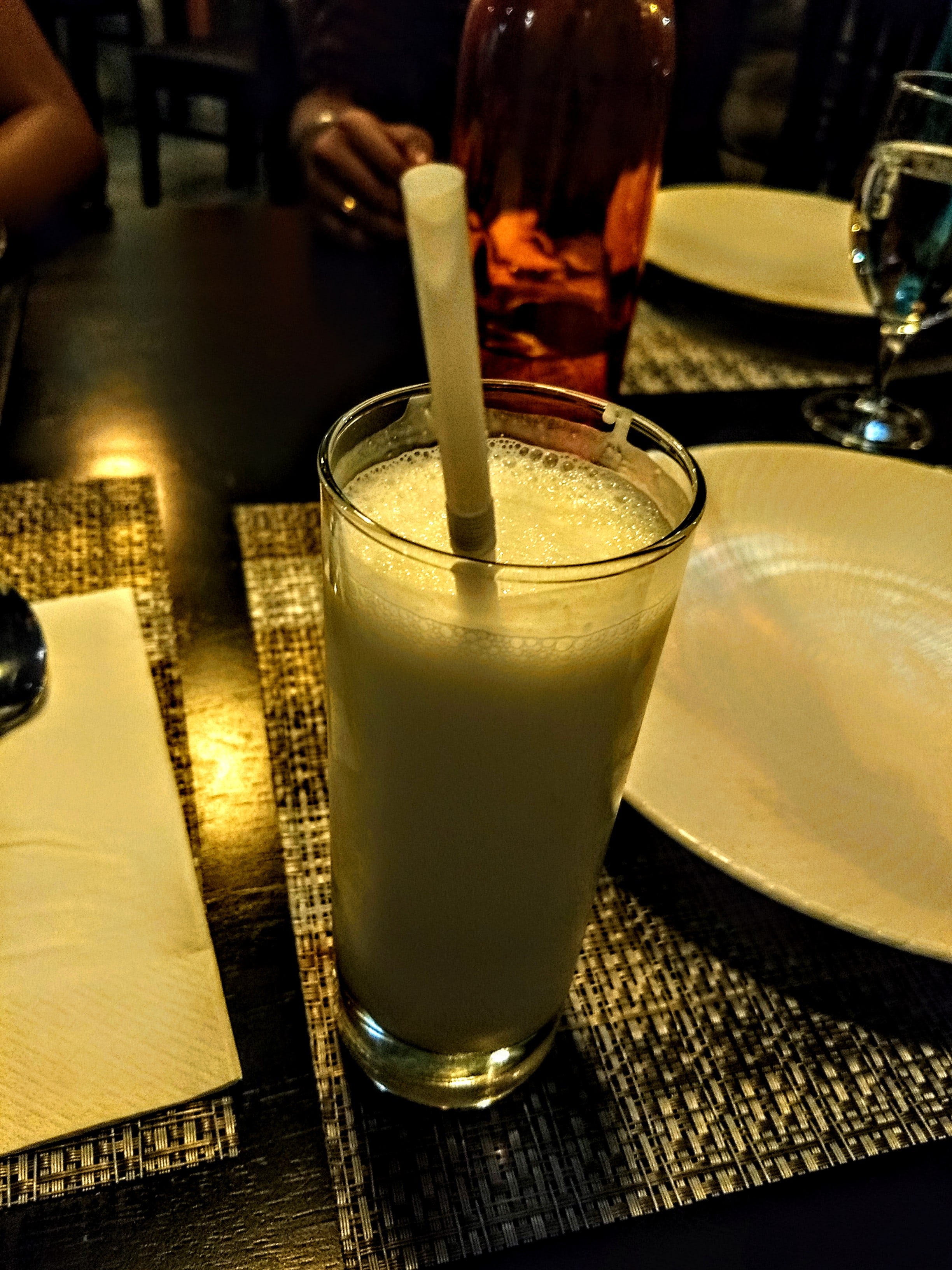
Butter Naan Bread: Naan bread is a type of bread made with flour. It is a flatbread that is baked in the oven. Naan bread often looks like a teardrop. It is often covered in herbs and spices to change the taste and have the flavour of butter. It is made from basic bread ingredients like wheat flour, yeast, salt, and butter or ghee. It also is made with yoghurt and milk. The yoghurt is what makes naan bread taste so much different than other kinds of bread.

Lamb Hyderabadi Biriyani: Lamb Hyderabadi biryani is one of India’s most famous biryanis and is so in Singapore. Some say biryani is synonymous with Hyderabad. The crown dish of the Hyderabadi Muslims, Hyderabadi biryani developed under the rule of Asaf Jah I, who was first appointed as the governor of Deccan by the Mughal Emperor Aurangzeb. It is made with basmati rice, spices and goat meat. Popular variations use chicken instead of goat meat. There are various forms of Hyderabadi biryani. One such biryani is the kachay gosht ki biryani or the dum biryani, where the goat meat is marinated and cooked along with the rice. It is left on a slow fire or dum for a fragrant and aromatic flavour.

Dal Makhani: Dal Makhani (buttery lentils) is a dish originating from the Indian subcontinent, notably in the Punjab region. The primary ingredients are whole black lentil, red kidney beans, butter and cream. The dish gets its richness from the use of the cream, but it can also be prepared with yoghurt, milk or no dairy.

Prawn Singaporean: Prawn Singaporean is a curry dish with Portuguese and Peranakan influences. Includes prawn, cabbage and capsicum in a curry sauce.
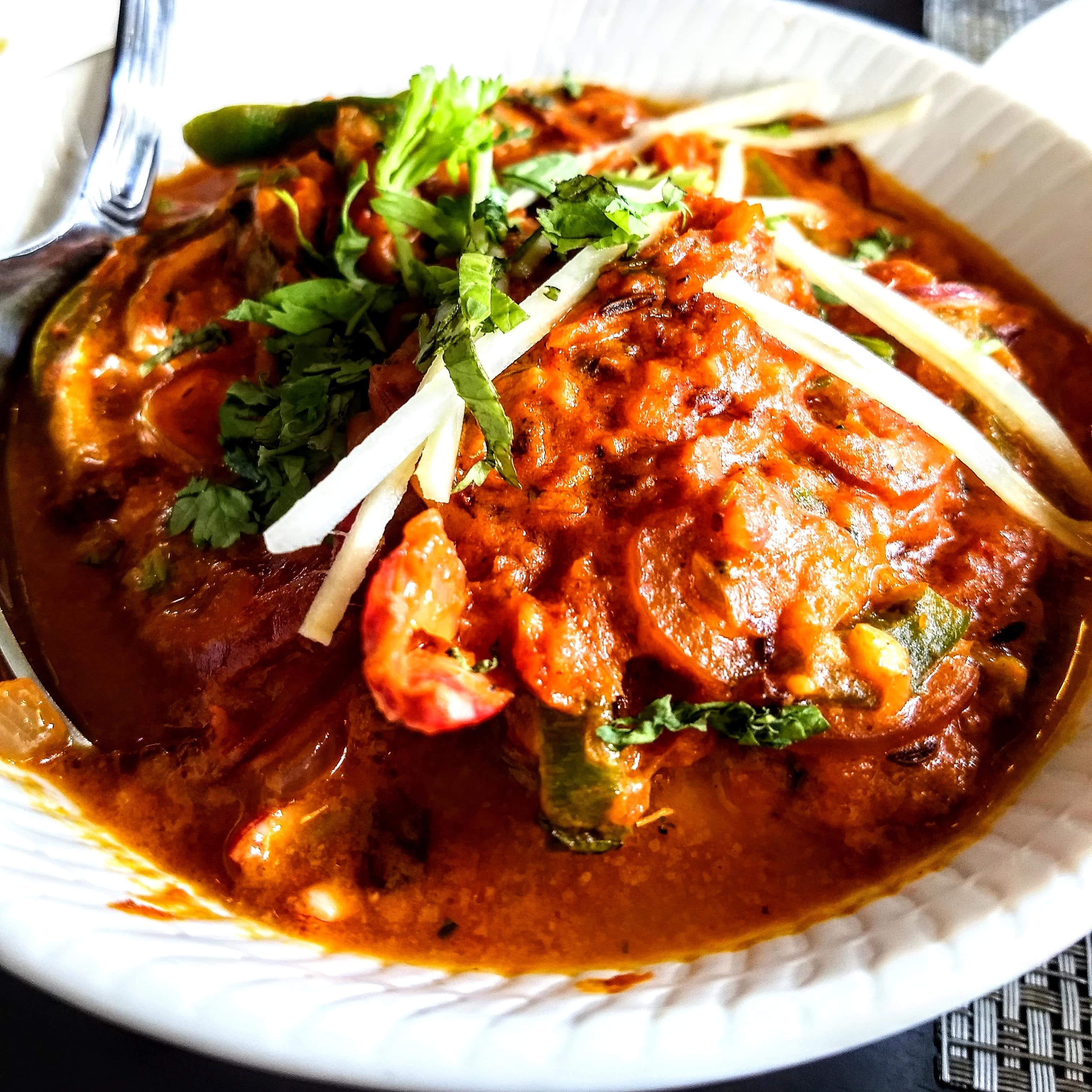
Jeera Rice: Jeera Rice is an Indian and Pakistani dish consisting of rice and cumin seeds. It is a popular dish in North India and Pakistan as an everyday rice dish. It is easy to prepare, unlike biryani. “Jeera” is the Hindi-Urdu word for cumin seeds. The ingredients used are rice, cumin seeds, vegetable oil, onions and coriander leaves. Cumin seeds are fried in hot oil. Long grain Basmati rice and salt are added to it. Water in an almost double quantity of rice is poured and allowed to boil with covered lid at high flame. The rice then is steamed on low flame until all the water is absorbed. Jeera rice is generally garnished with finely chopped fresh coriander leaves but is also garnished with onion rings in some Indian hotels and restaurants. Jeera rice recipe is not found in ancient books and scripts of Indian recipes and culinary art. Text about this recipe can be found in books and travelogues since the Mughal Empire. Mughals were fond of rice recipes, because of which cooks worked to invent new rice recipes as well as did experiments with tradition old recipes. Jeera rice recipe is one of those rice recipes. Later on, it was adopted in Indian cuisine and became so popular that the recipe is now cooked daily by almost every Indian family.
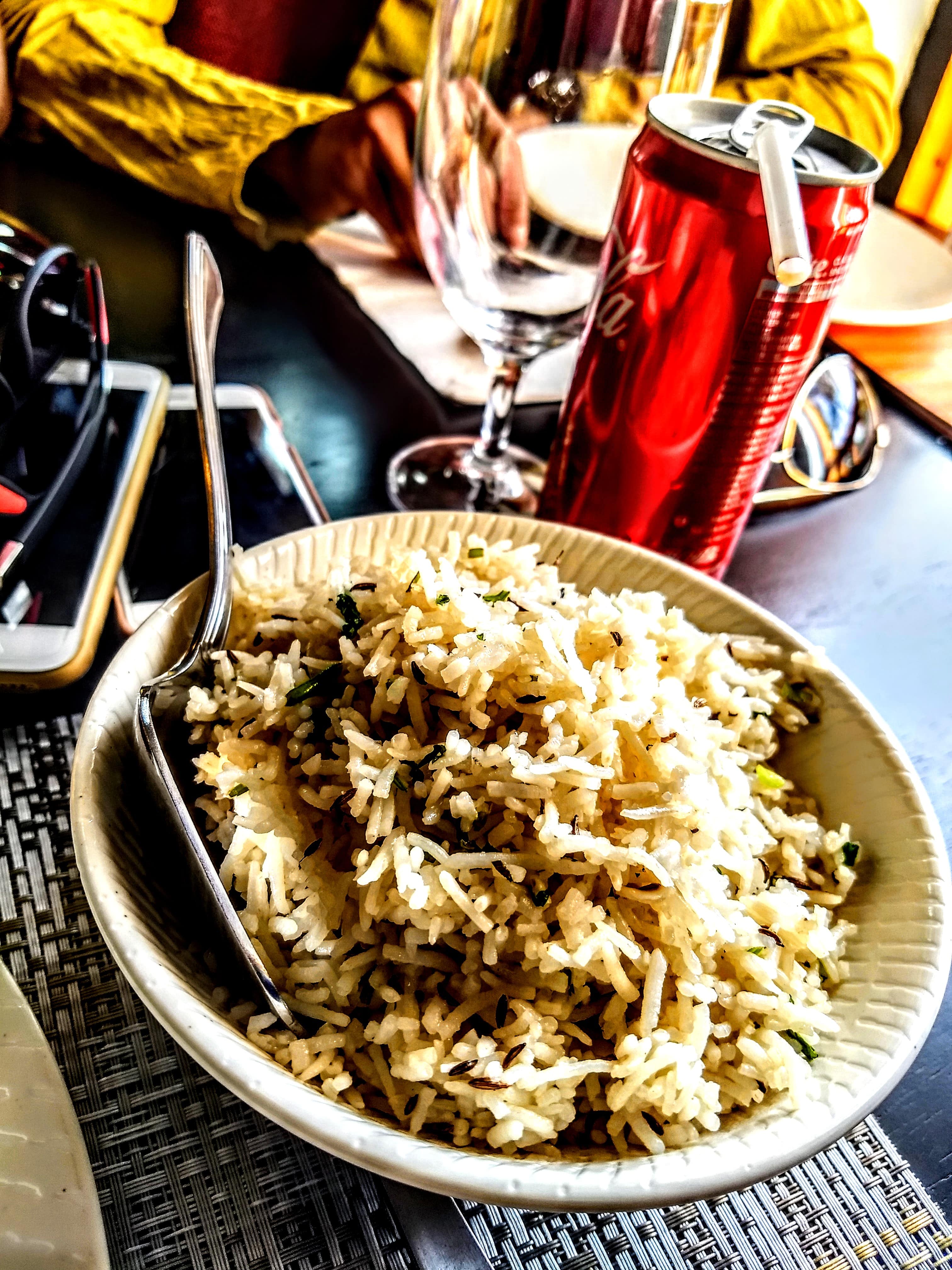
Tandoori Pomfret: Tandoori Pomfret is a fish dish prepared by roasting pomfret marinated in yoghurt and spices in a tandoor, a cylindrical clay oven. The dish originated from the Indian coastal regions and is popular in many other parts of the world. Singaporean loves this variety of Indian cuisine along with Prawn Kebabs.

Prawn Kebabs: Prawn Kebab dishes consist of prawns sometimes with fruits and vegetables; cooked on a skewer over a fire, or like a hamburger on a grill, baked in a pan in an oven, or as a stew; and served with various accompaniments according to each recipe.
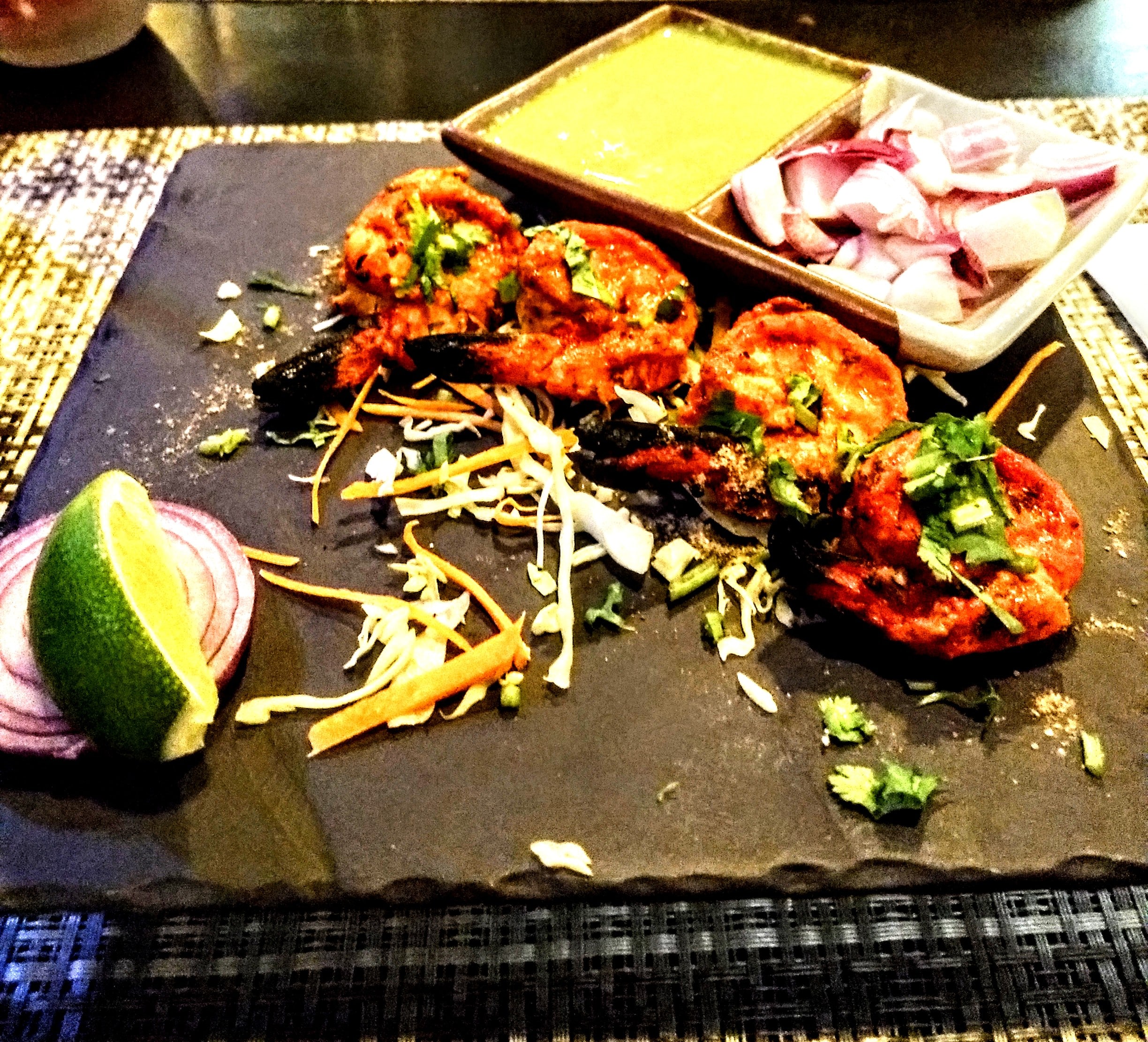
Another Indian restaurant I went to is called Village Curry, owned and run by a South Indian family and had a simple meal of consisting plain rice, lamb curry, mixed vegetables.
Then while visiting Sentosa Beach, I had the experience of tasting a unique Singaporean restaurant with a blend of Italian flavour. Name of the restaurant is Trapizza! There I had:

Seafood Pizza: Seafood Pizza is a savoury dish of Italian origin, consisting of a usually round, flattened base of leavened wheat-based dough topped with tomatoes, cheese, and various other ingredients like anchovies, olives baked at a high temperature. The pizza was a flat base one with mozzarella, cheddar and Parmigiano-Reggiano cheese topped with loads of squids, octopus, shrimps, salmons. It’s a delight for seafood lovers.
Classic Margareta: Classic Margareta is a typical Neapolitan pizza, made with San Marzano tomatoes, mozzarella cheese, fresh basil, salt and extra-virgin olive oil. Traditionally, it is made with fior di latte.

Coconut Water: Served in the traditional form i.e. in the coconut shell. This drink comes directly from nature right from the trees. The distinctive feature is that the Singaporeans don’t eat the white coconut malai, so the waiters were looking awkwardly at me while I was lavishing those.
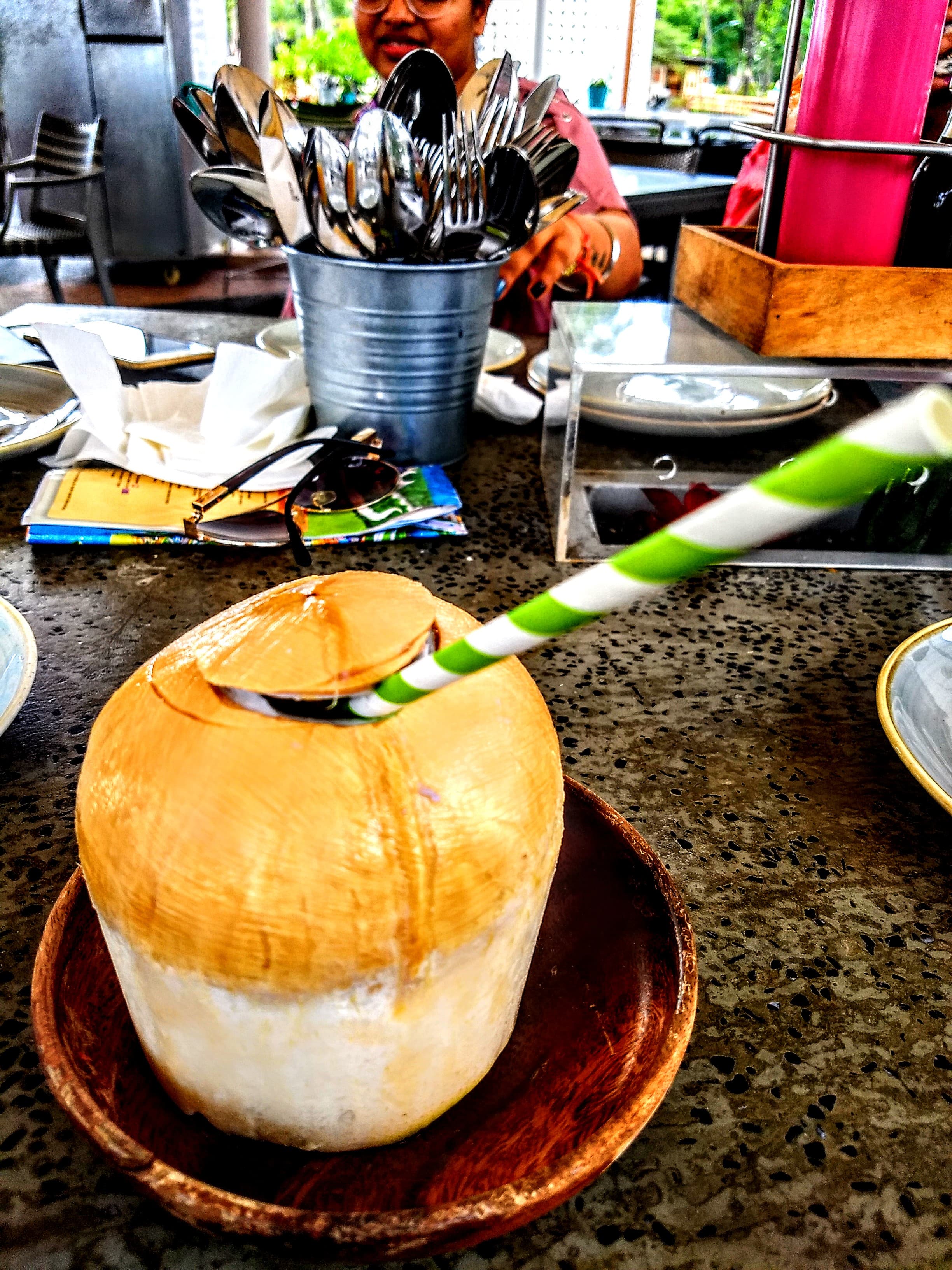
Singapore food isn’t complete without their fables street food. From the canteen of the National University of Singapore to the Hawker’s Stall, I am writing about the food with touched my heart with the flavours and textures:
Salmon Tama: From the canteen of the National University of Singapore I had the privilege to taste this unique Singaporean dish consisting of salmon fish which is boneless in nature. It did come in a bed of dull looking gravy but don’t go by the look as it tasted delicious. Topped with soya sauce and the egg-based gravy made this dish unique on its own.

Squid Roast: From the streets of Singapore I had squid roast. It is served as a stick consist of squids cooked on a skewer over a fire, or like a hamburger on a grill, baked in a pan in an oven.

Dory Fish: From the canteen of the National University of Singapore I had this dish consisting of spaghetti with chips, corns and dory fish. Again boneless sea fish fried and served with tomato sauce dipped spaghetti. It was an amazing experience tasting dory fish. (Yes the same we saw in the movies ‘Finding Nemo’, ’Finding Dory’).
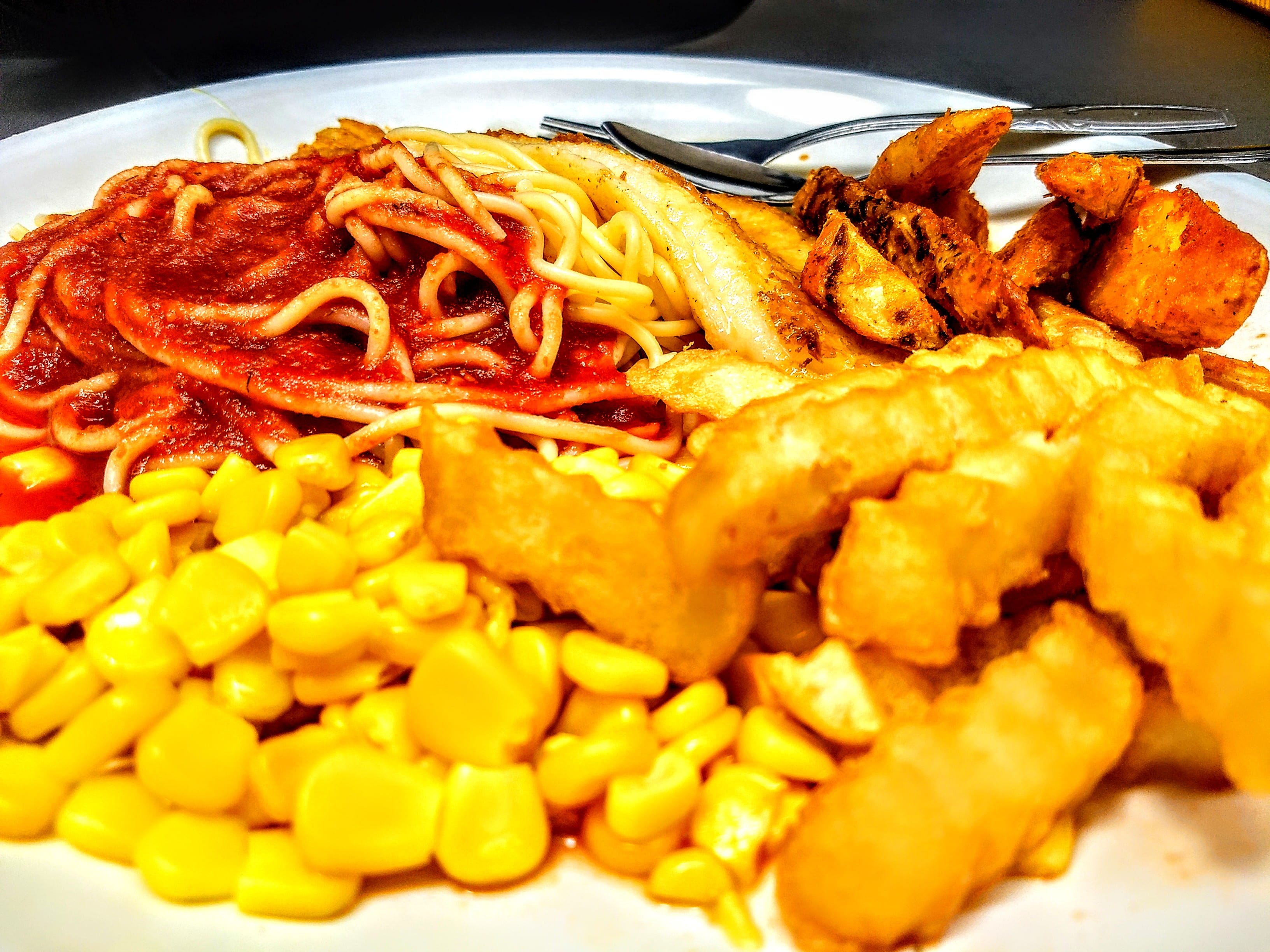
Nalla Jella: From the streets of Singapore came this dish where the fish Nalla is fried and served in hot spicy gravy. This dish will definitely pamper your taste buds.
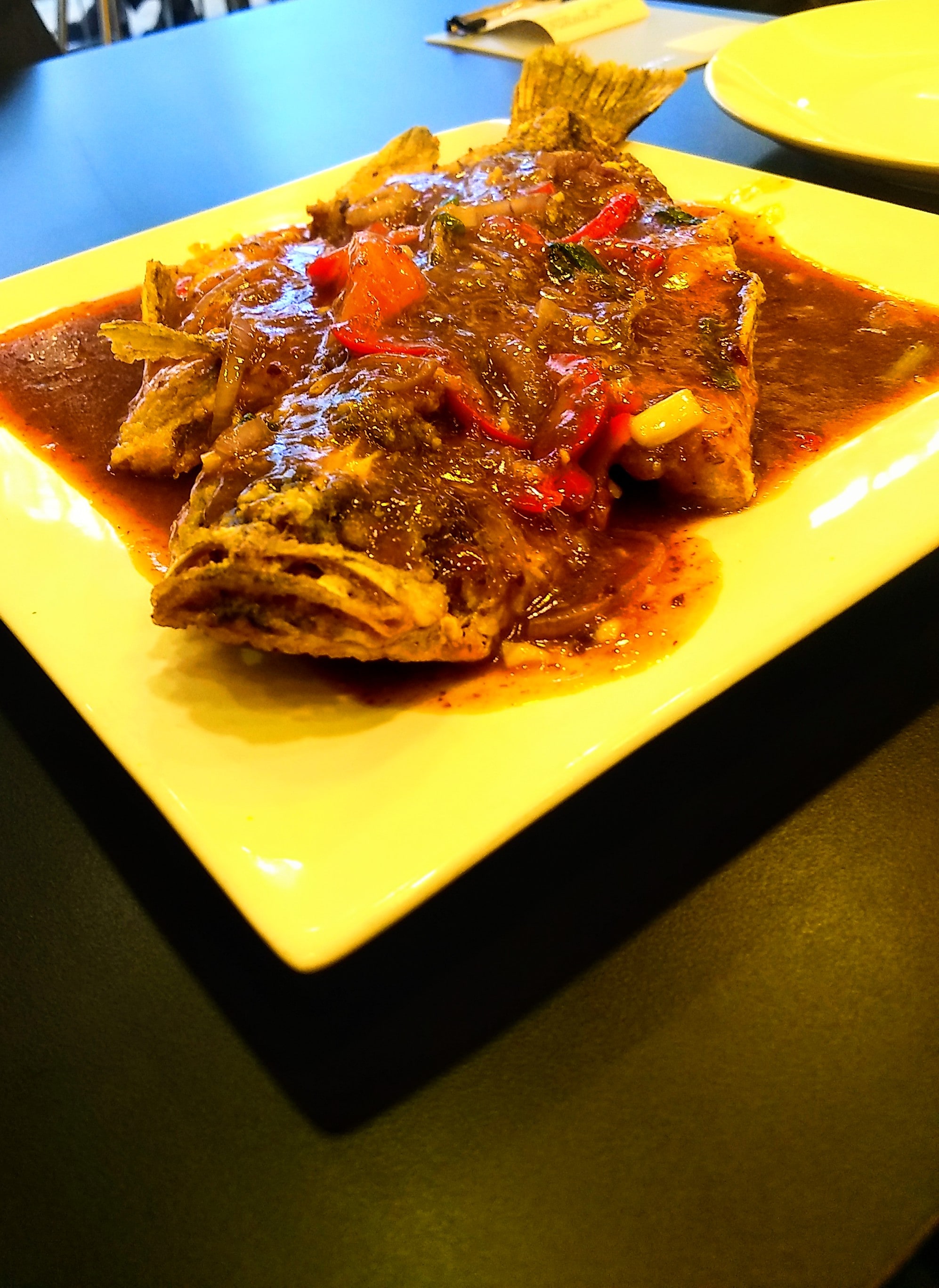
Mackerel Fry: From the canteen of the National University of Singapore came this simplistic dish. Its nothing more than mackerel fish fried in olive oil.
Roasted Duck with Rice: From the canteen of the National University of Singapore comes one of the unique signature dish of Singapore, roasted duck with rice. The duck is roasted in the oven then glazed in honey and hot sauce, sliced up and served on top of steam rice.

With that we come to the end of this post!
Singaporean Cuisine is 😍
Find Amamr Khabar on Instagram , Facebook
Follow us on WordPress by Clicking the follow button or sign up via email so that you dont miss any further posts!
Happy Blogging!
Happy Eating!































So awesome from clicks to content 🤘🤘🤘🤘
LikeLiked by 1 person
Thanks
LikeLike